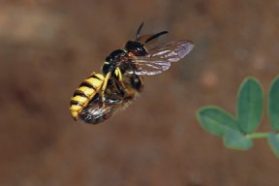A microbe nanny for young wasps
A smear of bacteria helps baby wasps survive infancy.
Share this:
- Share via email (Opens in new window) Email
- Click to share on Facebook (Opens in new window) Facebook
- Click to share on X (Opens in new window) X
- Click to share on Pinterest (Opens in new window) Pinterest
- Click to share on Reddit (Opens in new window) Reddit
- Share to Google Classroom (Opens in new window) Google Classroom
- Click to print (Opens in new window) Print
By Emily Sohn
Most parents would never consider putting a baby in a crib full of bees. Some wasp moms, however, do just that. It may sound like child abuse to you. Strangely enough, for the wasps known as beewolves, the behavior actually helps their young survive.
But wait. There’s more. After laying their eggs, female European beewolves also leave spots of white goo near the eggs. This goo is full of protective bacteria.
 |
|
A flying European beewolf carries a honeybee that she caught and paralyzed, which she will leave in a sealed chamber in the ground with her egg.
|
| Photo by Gudrun Herzner |
Scientists have long known about the curious behavior of beewolves. Before a female wasp lays her eggs, she digs a chambered burrow in the sand. Then, she goes out, stings a honeybee so it can’t move, and brings it back to the hole—again and again.
The wasp mom puts between one and five bees in each of the burrow’s chambers. After that, she lays an egg in each chamber and adds a glob of goo that comes out of her antennae. When the babies hatch, they eat the bees, which are paralyzed but still alive.
Scientists from the University of Würzburg, Germany, wanted to know what was in the goo. Using special, high-definition microscopes and genetic techniques, they found a new species of bacteria on the wasp’s antennae. The bacteria belong to a group called Streptomyces. These bacteria end up in the wasp’s goo.
The scientists propose that the bacteria in the goo protect baby wasps from diseases while they spend 4 to 9 months in their chambers. The chambers are warm and humid, perfect breeding grounds for killer germs.
To test this idea, the researchers used a thin glass rectangle to separate 15 baby wasps from their globs of goo. The babies couldn’t crawl on the slime or eat it. Only one baby from this group lived to adulthood. On the other hand, out of 18 babies that had access to their goo, 15 survived.
It’s possible that insect-bacteria relationships like this are common. So far, researchers have found one other example.
Warning: Don’t try this on baby brothers and sisters at home. Bees and bacteria may work for infant wasps, but for little people, warm milk and clean diapers are better bets.
Going Deeper:
Milius, Susan. 2005. Bacterial nanny: Beewolf grows microbe for protecting young. Science News 167(March 12):166. Available at http://www.sciencenews.org/articles/20050312/fob7.asp .
You can learn more about the European beewolf at www.innovations-report.com/html/reports/
life_sciences/report-41400.html (Siemens Innovations Report).







